Once you master the basics of fishing and score a few panfish, it is time to upgrade your skills and get yourself a bigger fish to fry! To do this, you must know how to use a baitcasting rod and reel.
You cannot catch big fish without a big fish rod – so get a baitcasting fishing rod and learn how to use it. This type of rod will enable you to target both freshwater and saltwater monsters. It will also help you level up your skills and cast more accurately.
The bad news is that you’ll need some time and effort to master using a baitcaster. The good news is I am here to help you out with useful beginner tips and pro advice. So, keep on scrolling, I promise it will be worth your time.
By the end of this article, you’ll have the know-how to use a baitcasting rod and baitcasting reel and perhaps even score your first big fish! Are you ready?
Let’s start!
What Is A Baitcasting Rod?
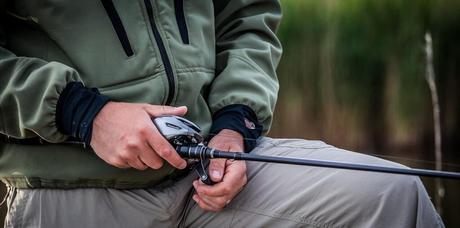
A baitcasting rod is a casting fishing rod equipped with a baitcasting reel. How is it different from spinning rods?
Both spinning fishing rods and baitcasting rods are highly popular among fishers. However, the two are quite different. If you are a beginner, you should better start off with a spinning reel & rod – baitcasters are reserved for more experienced fishers.
The main difference between a casting rod and a spinning rod is in the reel. Casting rods can be paired up with either a spincast reel or a baitcasting reel, while spinning fishing rods always go with a spinning reel.
Unlike spinning reels, baitcasting reels are positioned above the handle, facing upwards. The line guides are facing the same direction, as well.
Consequently, when battling a large fish hooked up on a baitcasting rod, the pole bends over with the guides facing up. In this way, the line is pushed down on the eyelets and the rod blank, and there is no risk of forceful fish pulling the guides off the rod.
Due to smaller guides, baitcasters release the line in a much tighter pattern than a spinning reel resulting in smoother casting with less drag. Less resistance on the line gliding through the eyes allows for better casting distance and accuracy, too.
Improved accuracy plays an important role in bass fishing, especially when you need a precise shot to catch a big fish lurking in a tight space (beneath tree logs and branches, under docks, etc.). Heavy-duty baitcasting rods are also a must when hoisting heavyweight bass out of thick vegetation.
If you want to set up a baitcasting fishing rod from a scratch, check out the following video:
Baitcasting Reel Pros & Cons
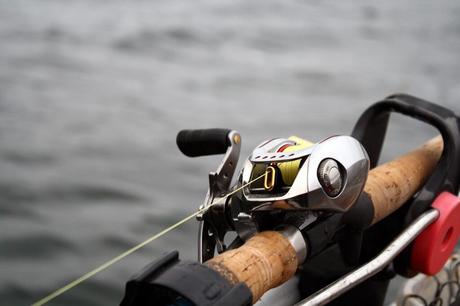
A fishing rod is worth nothing without a reel. Hence, fishing enthusiasts must strive to always find the best fishing rod & reel combo to match their fishing style and conditions on the water.
There is no universal reel that works best in every situation. They all have pros & cons – baitcasters included. Let’s see what those are.
Pros
- Braking system reduces the risk of nerve-racking backlashes
- Line comes out in a straight line, close to the rod blank, securing more accurate casts
- Can be used with a level-wind mechanism, which eliminates the need to use your thumb to guide the line
- Longer casts result in better water coverage
- Higher gear ratio and line speed secure fast retrieval (even in thick vegetation and heavy cover)
- Sufficient action and speed to handle specialized bait, such as crankbait and buzz bait
Cons
- Not suitable for new anglers – steep learning curve that requires time and practice
- Not the best option for casting lightweight bait
- When playing fish, a star drag feels a bit awkward in comparison to a lever drag
- The handle cannot be swapped from one side to the other (consider that when choosing a reel!)
What Is A Baitcasting Rod Used For?
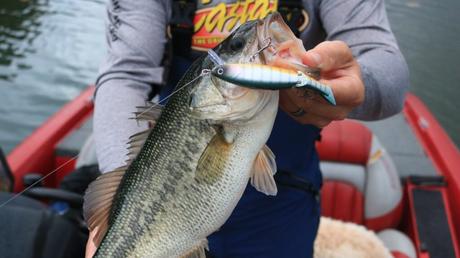
Baitcaster rods are best for (not limited to!):
- Power fishing bass (especially largemouth bass)
- Trolling
- Surf fishing
Baitcaster reels work best with specific angling techniques and tactics. For example, it is ideal for power fishing.
If you want to apply the punching, pitching, or flipping tactics to catch big bass, you need a heavier braided line and a baitcaster reel that can handle such a heavy application.
Even though most anglers identify baitcasting rods with freshwater bass fishing, they are not restricted only to bass. Baitcasters can be used to target a variety of fish, such as:
- Northern pike
- Muskellunge
- Blue catfish
- Flathead catfish
- Salmon
- Largemouth bass
- Striped bass
- Saltwater fish (except for big offshore species such as marlin or tuna)
As far as lures and bait are concerned, baitcasting poles can handle most applications. First and foremost, you must consider the weight of the lure. Casting lightweight lures can prove to be quite a challenge for inexperienced anglers.
Hence, if you are only just beginning to explore the world of baitcasting, stick to the lures that weigh at least ⅛ of an ounce (with a sinker). Live bait should also be used by more experienced anglers.
Here is the list of lures and bait most commonly used with baitcasting reels:
- Topwater lures
- Crankbait (Try the KVD Hard Knock Squarebill!)
- Jerk bait
- Spinnerbait
- Buzzbait
- Swim jigs
- Punch bait
- Swimbaits
- Flipping baits
- Soft plastics (plastic worms, speed worms, Senkos, flukes)
How Do You Use A Baitcaster Rod?
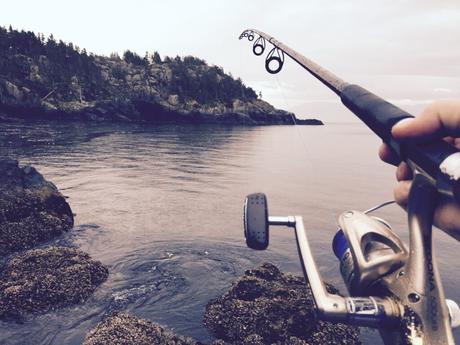
Even the best baitcasting reel and rod won’t make you a successful angler. Learning how to cast a baitcaster requires more time than mastering a spinning rod. You’ll have to put in an effort, but it will be worth it!
Here are the step-by-step instructions on how to use a baitcaster:
Set Up The Drag System
Setting the drag on the reel will significantly reduce the risk of backlashes and big fish breaking the line. All you need to do is find the control knob (it looks like a star) and set it up to about 20% of the strength of the line you use.
So, if you use a ten-pound line, you must set the drag system to release the line off the spool with two pounds of pressure. If you have a twenty-pound line on your reel, set the drag to four pounds. A perfectly set up drag system will help you catch more fish!
If you have never done it before, use a scale. Tie the end of the line to the scale and have someone hold it while you pull and bend the rod.
If the line comes off before reaching the desired weight (20% of the line weight), the drag is not tight enough and you must reel it back and tighten it. If you reach the 20% and the line does not start to come off, hold your position and turn the drag knob until it does.
Tie The Lure
Select a lure you want to fish with (mind the minimal lure weight we have discussed previously). Ensure that it is compatible with the line you already have on the reel and the type of fish you are targeting.
Once you tie the lure on, adjust the fishing reel to the lure’s specifications. It might come as surprise, but this step is necessary whenever you tie a new bait or lure. It is one of the things that makes a baitcasting pole so challenging to master.
On a brighter note, many anglers get used to adjusting the reel pretty quickly. Once you get a hang of it, too, you’ll need less than a minute to do it! Keep scrolling to become an expert!
Adjust The Braking System
If you drive a car, you’ll know how essential the brake system is. When it comes to the baitcasting reels, the braking system has the same function and equal importance as car brakes.
A braking system slows down the fishing reel and prevents the spool from spinning too fast or too much, which might cause a line twist or bird’s nest. As you can see, this step is crucial – do not skip it!
Beginners should turn on all the brakes on their reel. It will reduce the casting distance and eliminate the risk of a bird’s nest or a backlash. More experienced anglers that know how to avoid backlashes can remove a couple of brakes and enjoy a much greater distance on their casts.
Adjust The Spool Tension
As I have already mentioned, the spool tension must be adjusted every time you change the lure or bait. To do it properly, first, tighten the knob all the way to the right. Press the spool release button and check if the lure stays set.
If the lure falls down from the tip of the rod, the spool is not tight enough, and you need to readjust it and check once again. You are done tightening the spool once your bait stays put when you press the spool release button.
Your job is not concluded, though. You should reel the line in leaving about 4 – 7 inches of space between the lure and the tip of the rod, hold the rod up, and loosen the tension knob gently. Wait for the lure to start falling to the ground slowly and steadily, and then release the knob. It is a perfect setup for successful baitcasting!
If you have trouble setting up your baitcaster reel correctly, the following video might help you out:
Time To Cast
Congratulations, you are done setting up your reel. If you have done everything correctly, you should now have a lure anywhere from 6 inches to 12 inches from the top of the rod.
Make sure the reel is facing upward, press the thumb bar, and apply some force on the line to prevent your lure from hitting the ground. It will put the reel in free-spool, allowing the line to come off. Start casting your bait!
The Most Common Baitcasting Techniques
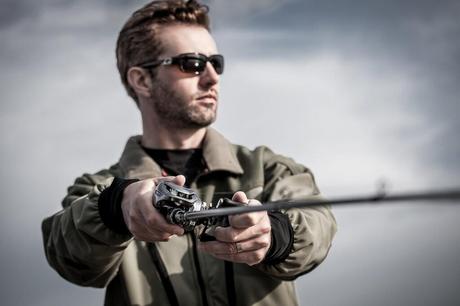
The two most common casting techniques you will see on the water are the overhead casting and the sidearm casting.
The Overhead Cast
The overhead casting delivers excellent casting precision and distance. It should thus be the first baitcasting tactic to master!
Here is how to do it:
- Hold your rod with both hands. Position the off-hand close to the lower end of the handle to secure sufficient power for your cast.
- Bring the tip of the rod behind you (over your head and shoulder) at about 45 degrees angle (approx 2 o’clock). Keep your dominant hand still – it should serve as a fulcrum. Pull with your off-hand.
- Make a casting motion, and once the tip of the rod is directly above your head (approx. 12 o’clock), release the line. Follow your lure and make sure it makes a more-less horizontal arc (avoid dropping it).
- Make a swift move towards the water and release the thumb bar and line at once – that will set your lure flying!
- A moment before the bait hits the water, arrest the motion of the spool with your thumb.
The Sidearm Cast
The sidearm cast is a go-to cast technique when you want to keep the lure low and avoid tree branches or other overhanging vegetation. Skilled fishermen use a shallow side arm cast to skip their bait over the water, which is an ideal technique for fishing under docks or piers.
Here is how to do it:
- Turn slightly sideways and grab your rod in one hand (with your non-dominant shoulder towards the water).
- Rotate the hand outwards so that you are looking down at the face of the reel.
- Continue to cast as you would in the overhead position.
- When the rod tip gets directly beside you, release the line and follow through, looking where the lure hits the water.
FAQs
What is a baitcasting rod used for?
A baitcasting rod is used for both freshwater and saltwater fishing. Contrary to popular opinion, it is not reserved for bass fishing only. You can use it to target an array of fish, such as pike, catfish, salmon, and numerous marine fish species.
Are Baitcaster rods different to spinning rods?
Baitcaster rods are different to spinning rods. The greatest difference is the reel. While baitcasters are equipped with a baitcasting reel, spinning fishing rods carry a spinning reel. Baitcaters are better suited for advanced anglers, too.
Can you use a baitcaster for regular fishing?
You can use a baitcaster for regular fishing – it is suitable for a wide variety of applications, including casting lures. However, the most popular use of baitcasters is freshwater bass fishing.
Can you use a baitcaster for everything?
A baitcaster can be used for almost everything related to freshwater or saltwater fishing. It works well with all line types (fluorocarbon, monofilament, braid). It is also compatible with most types of bait including topwater lures, jerk bait, crankbait, buzz bait, spinnerbait, swimbait, punch bait, flipping bait, and soft plastics.
Can you cast light lures with a baitcaster?
You can cast light lures with a baitcaster. To avoid backlashes and achieve long casts, use a 7’4″ rod and wider spool. Allow for longer leader length and adjust the magnetic brake control on your reel. Do not overpower the throw – use only your wrist and your arms.
’″
Final Thoughts
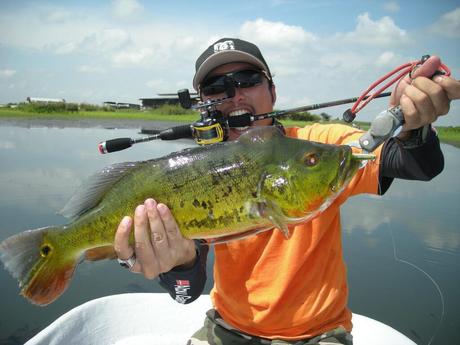
A baitcasting setup delivers a unique fishing experience. It is the right rod for skilled fishermen with “an educated thumb,” but if you apply everything you have read in this article, you’ll also be able to cast a baitcaster in no time at all.
Practice, improve your skill level, and start fighting big fish! If you need help, you know where to find me! Leave a comment, and I’ll get back to you!

